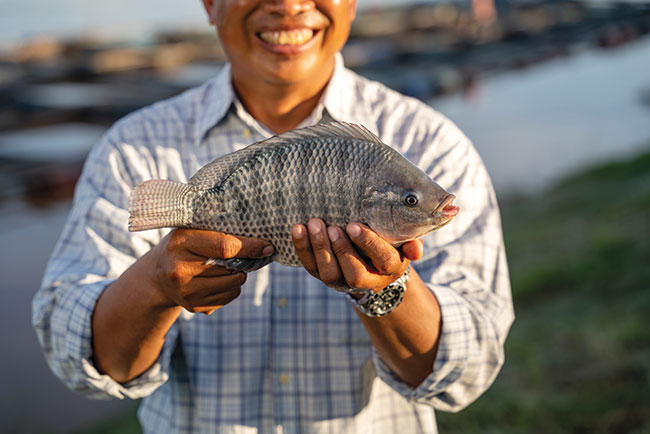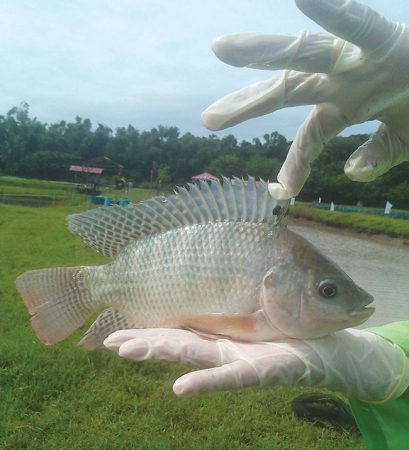
Features
Breeding
Fish Health
Research
Global tilapia research round-up
Latest research on one of the world’s most cultivated species
February 28, 2023 By Ruby Gonzalez
 (Photo: © tong2530 / Adobe Stock)
(Photo: © tong2530 / Adobe Stock) Tilapia is one of the world’s most farmed species, currently grown in more than 120 countries. It has a temperature tolerance that allows it to thrive anywhere from the Sub-Sahara to Scandinavia. The world’s top producers are China, Indonesia, Egypt, Brazil and the Philippines.
Favoured by the market because of its universal flavour profile, farmers say it has traits conducive to aquaculture. Highly adaptable, it has a fast growth cycle and known to survive in poor quality water and overcrowded environment.
As demand continues to grow, intensive fish culture is clearly the way to go. Systems and protocols that make it possible to deliver volume, ironically, are also creating multi-pronged sustainability challenges. High-volume stocking, for instance, raises environmental and fish welfare issues.
Overcrowding leads to accumulation of ammonia excreted by the fish. This inorganic compound of nitrogen and hydrogen affects health, growth and mortality parameters of even the hardiest of fish.
Developments from around the world addressing these issues are never lacking.
New protocols
Antibiotics and chemicals get the flak for the impact on fish bacterial resistance, ecosystems, human health and consumer perception. There may be alternatives that deliver desired results without the downsides.
Among these are the use of herbal and other non-antibiotic feed additives. In their study, researchers in China provided this option with compound additives of magnolol, palmatine and β-glucan at 0.24-0.48 per cent in in tilapia (Oreochromis niloticus) diet. The combination improved antioxidant activity, immune response and resistance to Aeromonas hydrophila. It also improved the anti-disease capacity of the animal.
The study is believed to be the first to report on the combined use in fish of magnolol, palmatine and β-glucan.
Per results, inclusion of 0.24-0.48 per cent compound additives improved the anti-oxidant-related parameters in the animal. Addition of same percentage volume also enhanced the immune response. Addition of 0.48 per cent compound additives enhanced enhance resistance of tilapia against A. hydrophila.
There was no impact on growth performance. Protein efficiency ratio in animal was improved, however.
“Although the mechanisms of action of magnolol, palmatine and β-glucan are different, they have synergistic effects in improving the antioxidant capacity of the body and promoting immune regulation,” Cao et al. explained.
Magnolol, extracted from the bark of Magnolia officinalis, has anti-oxidant and anti-inflammatory, and anti-bacterial properties.
Palmatine can be extracted from herbs. In addition to having anti-inflammatory and anti-oxidant effects, it also known to boost immunity.
β-glucan, widely found in nature has the ability to stimulate the immune system of different vertebrates, causing cells such as macrophages to produce immune memory.
Aeromonas hydrophila damages the gills, liver, and intestine, resulting in histopathological changes in the infected organs.
China is the world’s top producer and exporter of tilapia.
“Antibiotics are widely used as feed additives in aquaculture because of their excellent disease resistance and growth-promoting effects. On the contrary, long-term overuse of antibiotics not only affects ecosystems and human health, but may also lead to the development of resistance in pathogenic and non-pathogenic bacteria,” they summed up.
Formalin-killed vaccine
In Bangladesh, a major tilapia producer, a group of researchers focused on the development of a vaccine to fortify the fish resistance against diseases.
They have developed formalin-killed vaccine candidate against streptococcosis caused by Enterococcus sp. in Nile tilapia. The vaccine was prepared from E. faecalis, E. hirae and E. faecium against the streptococcosis in Nile tilapia. It is said to be the first in this field.
The study described vaccination as an environmentally friendly and safe disease-control strategy that boosts production. “Fish vaccine significantly improve the fish health and survival which reduce the farming cost. Consequently, it reduces the economic loss from fish farm by decreasing the disease related fish mortality,” said Akter et al.
Bacteria, borne from high-density stocking, are one of the leading pathogens causing fish disease all over the world. Streptococcosis is identified as being one of the prominent bacterial diseases in aquaculture that are caused by a multi-complex group of bacteria, they said.
“Antibiotic treatments are not effective to control the disease as the recurrent infection occurs after withdrawing the antibiotic application,” they cited. “Thus, vaccines appear to be the best preventive measures for disease management and considered as one of the safest tools that can replace the use of antibiotics,”
Mortality rate was lower in Nile tilapia given formalin-killed vaccine against Enterococcus sp. infection. “Formalin-killed vaccine with Enterococcus sp. were developed which improve the hematological parameters and IgM. Therefore, the mortality was reduced in the vaccinated fish and RPS (relative percent survival) were higher in the vaccinated group of tilapia,” they said.
“It indicates that the killed vaccine is effective to boost immunity in tilapia against the streptococcal diseases caused by E. faecalis, E. hirae and E. faecium. Vaccination with killed vaccine revealed a higher relative percent of survival,” Akter et al. said on “Development of formalin killed vaccine candidate against streptococcosis caused by Enterococcus sp. in Nile tilapia.”
Results, they stressed, showed that interperitoneal injection-vaccination method is better than BI for fish immunization with formalin killed vaccine. For the same purpose, bath immersion could also be an alternative strategy for the same purpose.

Tilapia grown at the College of Fisheries at Central Luzon State University in the Philippines (Photo: Dr. Ravelina Velasco)
Ammonia threshold
High levels of ammonia are formed in intensive fish farming systems. These can compromise fish immunity, growth or even cause mortality. Whatever the effect, the bottom line is impacted. Even at relatively low volumes, ammonia can cause chronic and acute toxic effects.
In Brazil, one of the world’s top producers of tilapia, another research breakthrough calculated the maximum threshold for ammonia that may be present in water for the safe culture of Genetically Improved Farmed Tilapia (GIFT) fingerlings: maximum of 0.48 mg/L fingerlings weighing at least 0.47 grams.
“No study in the literature has addressed the acute toxicity of NH3 in GIFT Tilapia. Due to the increasing relevance of this variety, research should be carried out to determine maximum NH3 concentrations that promote safe fish farming while ensuring high survival rates to increase zootechnical performance, without damage to vital structures, such as fish gills,” Ortiz et al. in their study, “Evaluation of acute toxicity of ammonia in Genetically Improved Farmed Tilapia”.
In aquaculture, ammonia come from fish excretion and uneaten feeds. There are also external contributors such as runoff from agricultural areas.
GIFT was found to be suitable to environment with potential risks to exposure to moderate NH3 concentrations. “GIFT is a strain with high tolerance to the toxic effects of NH3 and surpass the values previously reported in the literature,” they cited.
The research observed the acute toxicity of ammonia in fingerlings and juvenile GIFT Tilapia (average fish weights: 0.47, 6.54 and 19.11g), based on the evaluation of two factors: NH3 concentration and stocking density. Animals were observed in RAS.
Smaller GIFT fingerlings were more susceptible to the toxic effects of ammonia. Mortality rate above 60 per cent were posted for the initial concentral of 5.0 mg/L.
Experiments conducted confirmed that high mortality was a consequence of the toxic effects of NH3.
Additional salt in transportation water
Transport of live fish is another critical point in the industry. Stress stemming from transport may cause weight loss, deterioration of flesh quality and even mortality – all contributing to economic loss.
Adding 4 g/L salt to water may be what it takes to ease stress in Nile tilapia in transport. A study in Iran said that this protocol reduces stress in the animal. “Fish transportation is associated with drawbacks such as stress, hydromineal imbalance and oxidative stress. Thus, it is worth finding methods to improve fish health and welfare during transportation,” Yousefi et al. cited in “Alleviation of transportation-induced stress in Nile tilapia, Oreochromis niloticus, using brackish water”.
It was previously observed that fish transported in salt water exhibits lower degree of stress, lower hepatic damage, lower hepatic oxidative stress, and better hydromineral balance, although there is no benefit regarding water quality.
“According to the present results, 4 g/L salt is beneficial in Nile tilapia transportation. More comprehensive studies with mechanistic examination and timely sampling may better reflect the roles of salt addition on the fish health during transportation,” they said.
Water salinity had no significant effects on the water dissolved oxygen and ammonia levels. There was no significant difference in water pH after transportation
Adding 4 g/L salt to water suppresses hepatic oxidative stress and improves hepatic health. Addition of 2-4 g/L to water suppresses stress and hydromineral imbalance.
While adding salt to water for transportation of freshwater fish to ease transport stress is an acceptable practice, there are those who don’t believe in its merits.
The team evaluated the mitigation of stress responses, hydromineral disturbance and oxidative stress in O. niloticus transported in brackish water.
Quality of water during transportation is compromised by a number of factors. Fish increases oxygen consumption and carbon dioxide and ammonia excretion. Stress heightens cortisols, fish stress hormones, that may lead to mortality. The stressful condition increases metabolism rates, which may consequently lead to passive loss of internal ions and entering water to body.
The main studies cited in this article were published on Aquaculture Reports.
Print this page
Advertisement
- Aquaculture veterinary training initiative launched in Scotland
- Responsible Seafood centre announces new shrimp industry event in Vietnam





